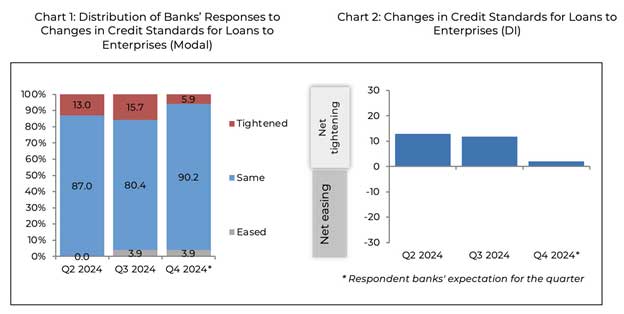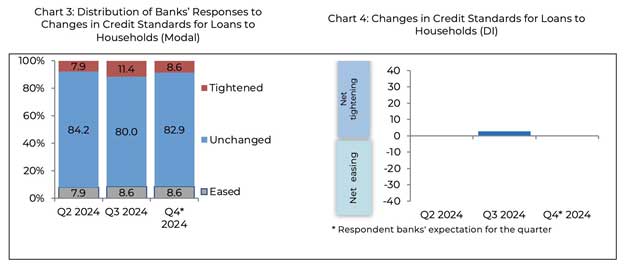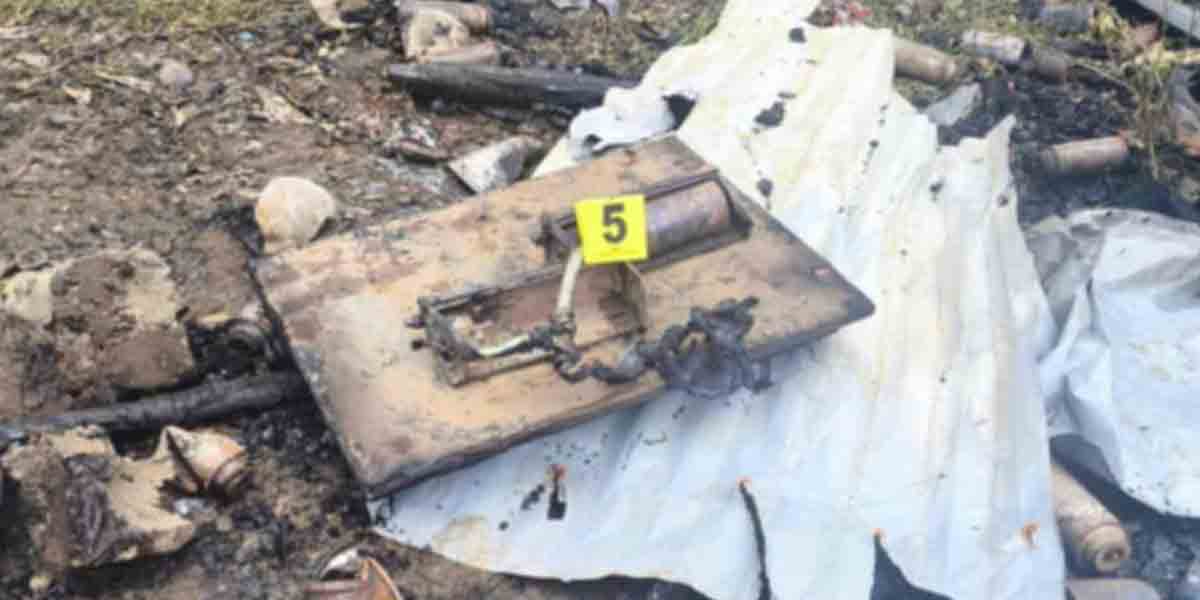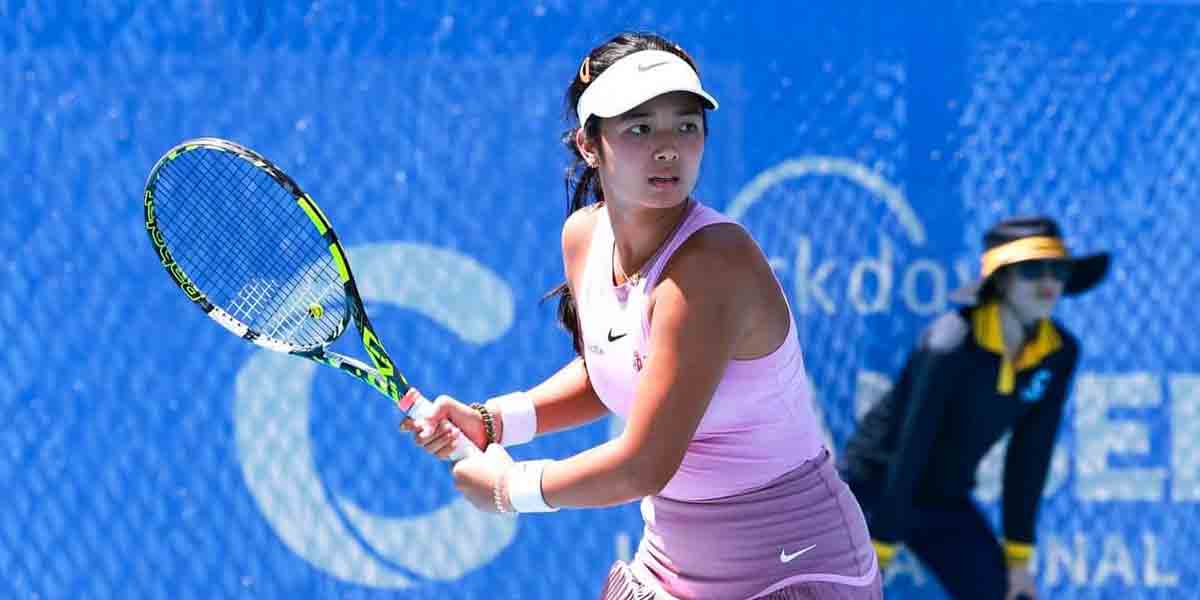Results of the Q3 2024 Senior Bank Loan Officers’ Survey (SLOS)[1] showed that most respondent banks maintained their credit standards for loans to businesses and consumers based on the modal approach.[2]
Meanwhile, the diffusion index (DI) method[3] indicated a net tightening of credit standards for business loans and household loans.
Changes in Credit Standards
Loans to Enterprises
The Q3 2024 survey results showed that majority of the respondent banks (80.4 percent) kept credit standards for firms steady based on the modal approach. This is a decrease from Q2 2024, where 87.0 percent of banks reported unchanged credit standards. Meanwhile, the DI approach showed a continued net tightening of credit standards in Q3 2024, attributed to the deterioration in borrowers’ profiles and the profitability of banks’ portfolios.
Over the next quarter, the modal approach suggests that 90.2 percent of respondent banks anticipate maintaining their loan standards for businesses. However, DI results showed a net tightening of credit standards for Q4 2024. This expectation is due to the deterioration in borrowers’ profiles and in the profitability and liquidity of banks’ portfolios, perception of stricter financial system regulations, and reduced tolerance for risk.

Loans to Households
Modal results indicated that a large proportion of banks have maintained their lending standards for household loans in Q3 2024 (80.0 percent), albeit this is a slightly lower than in Q2 2024 (84.2 percent). On one hand, the DI method reflected a net tightening of overall credit standards in Q3 2024, following unchanged loan standards in the previous quarter. This net tightening is mainly attributed to the deterioration in borrowers’ profiles and in the profitability of banks’ portfolios, as well as banks’ lower risk tolerance.
For Q4 2024, the modal results showed that most of respondent banks (82.9 percent) are expecting unchanged household loan standards. Similarly, the DI method indicated banks’ outlook of maintained lending standards amid expectations of unchanged tolerance for risk and stable profiles of borrowers.

Changes in Loan Demand
Loans to Enterprises
The majority of surveyed banks (72.5 percent) indicated unchanged overall demand for business loans in Q3 2024 as revealed by the modal results. The share of banks that reported steady demand for business loans during the quarter was marginally higher than in Q2 2024 (72.2 percent). Meanwhile, the DI method showed a lower net increase in loan demand from businesses in Q3 2024 compared to the previous quarter. Nonetheless, the net increase in business loan demand during the quarter is due to customers’ higher inventory and accounts receivable financing needs, as well as more optimistic economic outlook. [4]
In the following quarter, most of the surveyed banks (56.9 percent) expect broadly steady loan demand from businesses. Meanwhile, DI results showed that respondent banks anticipate a net increase in credit demand from enterprises in Q4 2024 driven mainly by businesses’ higher inventory and accounts receivable financing needs.

Loans to Households
Results based on the modal approach showed a slight decrease in percentage of banks indicating unchanged household loan demand in Q2 2024 (57.1 percent) compared to Q2 2024 (57.9 percent). Meanwhile, the DI approach showed a higher net increase in household loan demand in Q3 2024 compared to the previous quarter. This is driven mainly by banks offering more attractive financing terms and higher household consumption.[5]
Over the next quarter, modal results indicated that most respondent banks (60.0 percent) anticipate steady demand for household credit. However, DI results showed banks’ expectations of a net increase in household loan demand due to higher household consumption and banks’ more favorable lending terms.

[1] The SLOS consists of questions on loan officers’ perceptions relating to the overall credit standards of their respective banks, as well as to factors affecting the supply of and demand for loans to both enterprises and households. The analysis of the results of the SLOS focuses on the quarter-on-quarter changes in the perception of respondent banks. The responses for the Q3 2024 SLOS were gathered between 10 September to 15 October 2024 with a total of 52 respondent banks out of 60 surveyed banks, reflecting a higher response rate of 86.7 percent compared to 91.7 percent response rate in the previous quarter.
[2] In the modal approach, the results of the survey are analyzed by looking at the option with the highest share of responses. The three options for the modal approach are either 1) tightening, 2) easing, or 3) unchanged credit standards for loans to enterprises and for loans to households.
[3] In the DI approach, a positive DI for credit standards indicates that the proportion of respondent banks that have tightened their credit standards exceeds those that eased (“net tightening”), whereas a negative DI for credit standards indicates that more respondent banks have eased their credit standards compared to those that tightened (“net easing”). Meanwhile, an unchanged credit standards in the DI approach indicates that the proportion of the respondent banks that have tightened their credit standards is equal to those that eased their credit standards. During the Q1 2010 to Q4 2012 survey rounds, the BSP used the DI approach in the analysis of survey results. Beginning in Q1 2013, the BSP used both the modal and DI approaches in assessing the results of the survey.
[4] The BSP Business Expectations Survey (BES) indicated that the firms’ upbeat business confidence in Q3 2024 was buoyed by their anticipation of: (a) increase in demand for certain goods and services such as food and beverage, apparel, education, and personal services, (b) easing inflation, (c) seasonal uptick in business activities due to the start of the new school term and the pre-holiday inventory stocking by retailers, and (d) expansion and improvement of business operations.
[5] The BSP Q3 2024 Consumer Expectations Survey (CES) indicated that consumer sentiment for Q3 2024 improved due to expectations of: (a) higher income from wages/salaries, remittances, and other sources, (b) additional sources of income, (c) permanent employment and more available jobs, and (d) additional working family members.






















